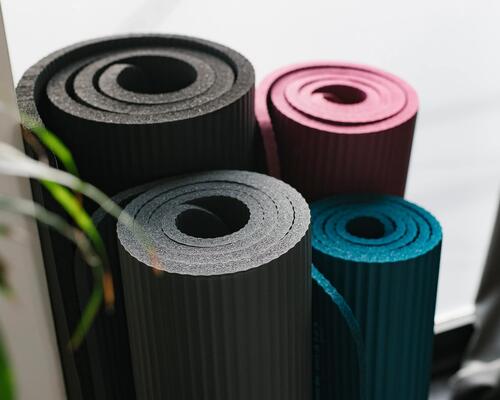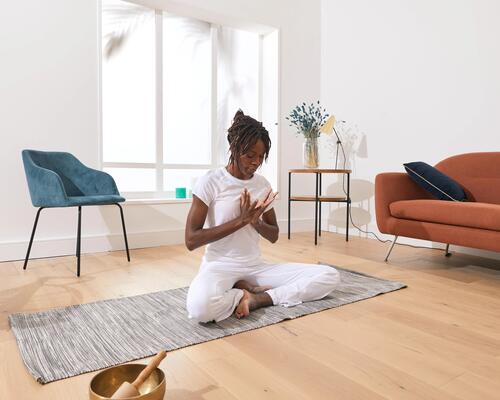1. The butterfly
In a seated position on the floor, place your feet together (with the soles touching) in front of you, approximately 30 cm (12 in.) from your pelvis. Place your hands on your ankles or your legs, whichever is more comfortable. While engaging your glutes, gently lower your knees outward towards the floor on either side of your body. With each exhalation, bring your knees closer to the ground for a deeper stretch. Alternate holding and releasing the stretch in sync with your breath. Repeat 3 to 5 times.
Some of the benefits:
○ Stimulate the heart and improves the oxygenation of your blood flow;
○ Stretches out the thighs and the knees;
○ Tones the back muscles;
○ Relaxes the pelvis and the hips.
Contraindications:
Do not practice this pose if you have just finished eating or completing an intense physical effort.
2. The half-bridge (inverted pose)
Lie on your back with your arms along the sides of your body, and the palms of your hands facing down. Bring the heels of your feet towards your buttocks. Keep your knees in line with your hips, push with your feet and your arms against the floor to lift your pelvis and engage your glutes. Your shoulders must stay on the ground. Protect your neck by bringing your chin down towards your sternum. Repeat 3 to 5 times.
Some of the benefits:
○ Works your abdominal breathing;
○ Strengthens the legs;
○ Stretches the back and the abdominals;
○ Eases tension in the knees;
○ Improves overall flexibility.
Contraindications:
If you have a back or shoulder injury, a sciatica issue, or you are pregnant, avoid this doing this pose too often (if at all).
3. The camel
Standing on your knees, place your hands on your lower back with your fingers facing downwards. Stretch out your torso and push your pelvis towards the front and protect your lower back by engaging your abdominals. Keep your head aligned with your spine. Tuck your pelvis in and bring your shoulder blades together while pushing your shoulders towards the back. With the exhalation, arch your back a little more and push your chest up towards the ski. If you are able to, you make grab hold of your ankles as you bend backwards. Hold and repeat 3 to 5 times as needed.
Some of the benefits:
○ Stretches the hamstrings;
○ Relaxes the chest and the throat muscles;
○ Tones the abdominals;
○ Deepens the breath.
Contraindications:
Be careful or avoid this pose if you suffer from sciatica, a hernia or if you have recently undergone abdominal surgery. If you suffer from arthritis or osteoarthritis of the knees, hips, lower back or shoulders, this pose should be avoided.
4. The cow's face
In a seated position on your mat, with one leg crossed over the other and your foot planted on the floor. Join your hands behind your back with one arm coming from the top and one from the bottom, and interlock your fingers. If you have difficulty linking your fingers, use a strap to bring your arms closer to one another behind your back.
Bing your shoulder blades together by pushing your shoulders back to open your chest and extend your elbows in opposite directions while keeping your shoulders loose. Restart by alternating the leg that crosses over and changing the position of your hands (switch the arm that is on top and the one on bottom). Repeat 3 to 5 times on each side for the most benefits.
Some of the benefits:
○ Regulates the heart beat;
○ Relieves sensations of heaviness;
○ Stretches the back muscles;
○ Improves concentration.
Contraindications:
This pose should not be overly challenging, or cause any pain. It is meant to be relaxing. If you feel any pain, relieve pressure and relax the position. Always keep this in mind.
5. Downward facing dog
Start on all fours in the table position. Push your hips upwards by stretching out your legs and arms so that your body forms the shape of the letter A. Plant your hands firmly on the ground and spread out your fingers. Stretch out your spine by lifting your pelvis in the air and pushing with your hands against the floor to elongate your body. Remember to avoid lifting your shoulders towards your ears. Push your heels towards the mat, but don't force this movement. Keep a slight bend in your knees if necessary to keep your lower back elongated. You can pedal your feet gently if you'd like to alternate bending your knees one after the other. Hold the pose, then slowly return to your starting position. Repeat 3 to 5 times as needed.
Some of the benefits:
○ Engages the whole body;
○ Strengthens muscles in the back, legs and thighs;
○ Develops lung capacity;
○ Softens the joints in the fingers, hands, arms, shoulders, feet and ankles.
Contraindications:
Be careful doing this pose if you have high blood pressure and it makes you feel uncomfortable. Also be careful if you are prone to headaches, diarrhea or if you have any cervical issues or inflammation in your eyes, legs, ankles, knees, hips, wrists, arms or shoulders.
6. The twisted lizard
Start on all fours. Place one foot on the floor on the outside of your hands. Move your body forward and let the other knee come to the floor. Keep the knee that is in front behind the toes, do not push it too far forward. Lift your back foot towards the sky and, with the hand that is the same side as your forward leg, grab hold of your ankle behind you by twisting the trunk of your body. Place the other hand on the floor underneath your shoulder. Keep your back straight and your shoulders loose. Hold the pose, then restart on the other side. Repeat this routine 3 to 5 times for best results.
Some of the benefits:
○ Stretches the thighs, back and shoulders;
○ Works your balance and mobility;
○ Relieves tension in the back and spine;
○ Works your concentration.
Contraindications:
This pose is very liberating, both physically and mentally, but always pay attention to your limitations. Be very careful with full-body twists if you have any digestive issues, if you are pregnant or if you have undergone abdominal surgery.
7. Kneeling head-to-knee
Start on your knees with your hands on the floor. Stretch one leg out in front of you by passing the foot between your hand and placing the heel of the foot on the floor. While keeping your other knee bent, lean your body forward over the outstretched leg. For a deeper stretch, push the hip of the extended leg back and down. Hold the pose, then slowly return to the starting position and repeat on the other side. Repeat 3 to 5 times as needed.
Some of the benefits:
○ Stretches the hamstrings;
○ Relieves tension in the back, hips, legs, shoulders, elbows, wrists and fingers;
○ Stabilizes blood pressure.
Contraindications:
If you have knee injuries, this exercice is not recommended. Otherwise, pay attention to your body when practicing this pose. One side of your body may be less flexible than the other, which is entirely normal. In order to avoid injury, it is important to respect the limitations of your body.
8. The seated pigeon
In a seated position on the floor, lift your knees towards the sky. Place both arms towards the back and place your palms on the ground with your fingers facing towards the back. Keep your arms straight and your neck in line with your spine. Move your shoulders down from your ears with a slight bend in your elbows if necessary. Place your right ankle on your left knee. Hold the position keeping both legs engaged. Return to a neutral position. Proceed on the other side (left ankle on right knee). Repeat 3 to 5 times as needed.
Some of the benefits:
○ Stretches the thighs, knees and shoulders;
○ Stimulates the external rotators of the hips;
○ Relieves pressure in the back.
Contraindications:
There are very few constraints with this pose. You should always pay attention to your body and any feelings of pain. Respect your own limitations.









